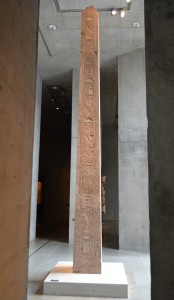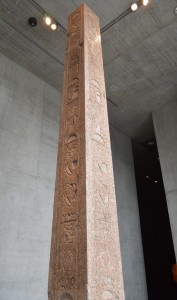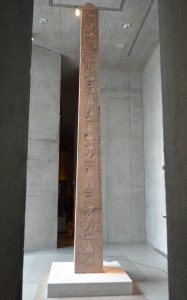|
|
Titus Sextus Africanus Obelisk
| Present Site: | Staatliches Museum Äegyptischer Kunst (State Museum of Egyptian Art), München (Munich), Germany N 48°08'49.9"(48.147189) E 11°34'06.2"(11.568401) |
| Pharaoh: | Titus Sextus Africanus (Nobleman of Ancient Rome) (1st Century) |
| Measurement: | 5.6 meter high |
| Stone: | Red granite |
About The Site:
Staatliches Museum Äegyptischer Kunst (State Museum of Egyptian Art) is the Bavarian State Museum in Munich, Germany. Previously, a part of Residenz (Royal Palace) had been used as a museum, it was relocated to a new building in June 2013. New building is a large building as you see the picture below, but the Museum of Egyptian Art is in the basement, and on the ground, it's also used for Hochschule fur Fernsehen und Film Munchen (Munich University for TV and Film).
The entrance for the Museum of Egyptian Art is in the basement of a huge stone wall-like building on the right side of the building. This is a unique design as a museum that we feel like entering into Pyramid. The scale of the museum is not so large, but it has richer contents than the impression of "State Museum". At the corner of Ancient Egypt, they are separated by the theme, such as a room for the history of hieroglyph by each time, or an exhibition on the Ancient Egyptian's religious idea. Also there are exhibitions for Ptolemaic dynasty (After Ancient Egypt) and for Ancient Roman Empire Era. The obelisk is exhibited in this Ancient Roman corner.

|
Thers are also a specific corners for Nubia dynasty, for stone materials from various Egyptian regions, for making process of stone statues, etc. Thus, there are many exhibitions and they are displayed with ingenious ideas.
This would be in the leading level in the world as a museum on Ancient Egypt, and it would take more than 3 hours for looking around all the exhibitions.
How To Get There:
The most convenient way is using the Tram from the Minich Central Station (München Hauptbahnhof), getting off at Karolinenplatz. However, It's walkable distance to the Museum, about 1 km from the Central Station.
Just for your reference, a large black obelisk is standing in the middle of Karolinenplatz. This is not an authentic Egyptian obelisk, but the memorial which was erected in 1833 for the 30,000 Bavarian soldiers, who died in the war against Napoleon, with 29 meters high.
|
(Excerpt from the Part of Provenance) |
About The Obelisk:
The description plate at the bottom of the Obelisk says: "Titus Sextius Africanus Obelisk, Roam Era, 50 AD", and the web site (in German) of this Museum says: "5.6 m high".
An another description in this Museum says more detailed story on this obelisk. According to this, founder of this obelisk "is specified Titus Sextius Africanus, Roman Empire's prefect in Egypt in the year 59 AD, according to the name engraved on this obelisk". However, according to Wikipedia (in English) entitled "List of governors of Roman Egypt", the name of governor of Roman Egypt in the year 59 AD is Tiberius Claudius Balbillus Modestus, and his name (Titus Sextius Africanus) is not listed as governors of Roman Egypt.
On the other hand, his name appears in the Wikipedia (in English) entitled "List of Roman consuls", as a "suff. (consul suffectus / suffect consul)" in July-December 59 AD. At that era, every consuls resigned during his term, and replaced by consul suffectus (suffect consul). So, Titus Sextius Africanus governed Egypt as a "real" consul in July-December 59 AD. But it's unknown where this obelisk erected on ancient Rome.
Around 1775 it was moved to the Villa Albani in Rome, after the sculptor Paolo Cavaceppi had restored the top and bottom of the original centre stone. This was brought to Paris in 1797 by Napoleon, as loot from his Italian campaign, it was erected there as part of a monument to General Desaix at the Place des Victoires. Then, The son of Bavarian King, Maximilian I, future King Ludwig I, who was a crown prince at the time, bought this obelisk to Munich in 1815. From 1830 up until World War II, this was standing in the Egyptian Hall of the Glyptothek, which is a museum for the collection of Greek and Roman sculptures, built by Bavarian King Ludwig I. This Glyptothek was heavily damaged by WW II, and reopened in 1972 after the restoration. During the restoration, the Egyptian Museum was opened in 1972, and the obelisk was displayed in front of the museum, at a corner of Residenz (Royal Palace), until 2007. The status at that time can be seen at here. After June 2013, when the current Staatliches Museum Äegyptischer Kunst (State Museum of Egyptian Art) was opend, the obelisk is displayed indoor.
The obelisk is placed in a narrow space between the window and the wall. Hence the picture of the entire obelisk can be taken from only the left and right of passage. Therefore, it overlooks the whole of the four sides is difficult, but it was the same inscription all the result of comparing the four sides.
Most websites says the obelisk is "5.8 m high", probably that data was copied and copied. However, I beleive this must be corrected to 5.6 m, which the museum's description says so.
Notes For Pictures:
It was hard work to take a picture of whole obelisk, because it can be taken from only the both side of passage. It was easy to take pictures of four sides when the obelisk was standing in front of the entrance of the museum, before the current museum is made. With regard to the current exhibition way, I think a little disappointing.
 Left Side |
 Left Side and Front |
 Right Side |
Right Side and Back |
|||
April 23, 2016 by Hiroyuki Nagase (For high definition image, please click the picture) | ||||||
Copyright Hiroyuki Nagase nagase@obelisks.org and Shoji Okamoto okamoto@obelisks.org